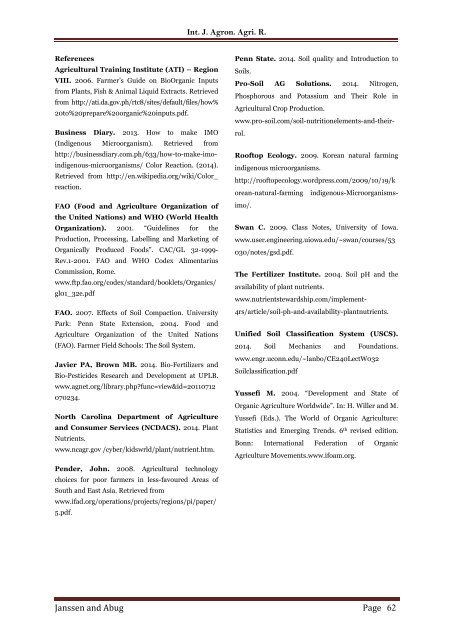Paspalum conjugatum and Cynodon dactylon as organic bio-fertilizers in growing Brassica juncea (Lettuce plant)
Abstract A comparative study was done to determine the growth of Brassica juncea (Lettuce plant) using organic biofertilizers. The development of an Indigenous Microorganisms (IMOs) through the use of Paspalum conjugatum (Carabao grass) and Cynodon dactylon (Bermuda grass) was done as the organic bio-fertilizer. Evaluation of the soil sample was first done to determine the soil’s engineering properties which can directly affect the growth of the plant. The results illustrated that the soil sample was fine-grained with silt and clay as the predominant particles indicating that the soil sample had lesser permeability but with greater water-holding capacity. Furthermore, investigation of the soil’s properties indicated an acidic nature and the soil sample had less macronutrient (Nitrogen, Phosphorus and Potassium) contents but was rich with micronutrients. Application of the organic matter of both grasses as an introduced IMO was of variable formulation in a ratio of 10%, 25% and 50% with the soil sample. Based on the results of the study, the most effective bio fertilizer was Paspalum conjugatum since it gives more benefits in terms of the growth of the plant with healthy leaves & stems and it had lower mortality rate when compared to Cynodon dactylon. Application of the new technological approach with the creation of Indigenous Microorganisms (IMOs) through utilization of grasses, can be of great help to farmers in growing crops since it can provide an added nutrients and growth hormones essential for plant growth and development and at the same time economical for the bio fertilizers formulated were made of grasses.
Abstract
A comparative study was done to determine the growth of Brassica juncea (Lettuce plant) using organic biofertilizers. The development of an Indigenous Microorganisms (IMOs) through the use of Paspalum conjugatum (Carabao grass) and Cynodon dactylon (Bermuda grass) was done as the organic bio-fertilizer. Evaluation of the soil sample was first done to determine the soil’s engineering properties which can directly affect the growth of the plant. The results illustrated that the soil sample was fine-grained with silt and clay as the predominant particles indicating that the soil sample had lesser permeability but with greater water-holding capacity. Furthermore, investigation of the soil’s properties indicated an acidic nature and the soil sample had less
macronutrient (Nitrogen, Phosphorus and Potassium) contents but was rich with micronutrients. Application of the organic matter of both grasses as an introduced IMO was of variable formulation in a ratio of 10%, 25% and 50% with the soil sample. Based on the results of the study, the most effective bio fertilizer was Paspalum conjugatum since it gives more benefits in terms of the growth of the plant with healthy leaves & stems and it had lower mortality rate when compared to Cynodon dactylon. Application of the new technological approach with the creation of Indigenous Microorganisms (IMOs) through utilization of grasses, can be of great help to farmers in growing crops since it can provide an added nutrients and growth hormones essential for plant growth and development and at the same time economical for the bio fertilizers formulated were made of grasses.
Create successful ePaper yourself
Turn your PDF publications into a flip-book with our unique Google optimized e-Paper software.
Int. J. Agron. Agri. R.<br />
References<br />
Agricultural Tra<strong>in</strong><strong>in</strong>g Institute (ATI) – Region<br />
VIII. 2006. Farmer’s Guide on BioOrganic Inputs<br />
from Plants, Fish & Animal Liquid Extracts. Retrieved<br />
from http://ati.da.gov.ph/rtc8/sites/default/files/how%<br />
20to%20prepare%20<strong>organic</strong>%20<strong>in</strong>puts.pdf.<br />
Bus<strong>in</strong>ess Diary. 2013. How to make IMO<br />
(Indigenous Microorganism). Retrieved from<br />
http://bus<strong>in</strong>essdiary.com.ph/633/how-to-make-imo<strong>in</strong>digenous-microorganisms/<br />
Color Reaction. (2014).<br />
Retrieved from http://en.wikipedia.org/wiki/Color_<br />
reaction.<br />
FAO (Food <strong>and</strong> Agriculture Organization of<br />
the United Nations) <strong>and</strong> WHO (World Health<br />
Organization). 2001. “Guidel<strong>in</strong>es for the<br />
Production, Process<strong>in</strong>g, Labell<strong>in</strong>g <strong>and</strong> Market<strong>in</strong>g of<br />
Organically Produced Foods”. CAC/GL 32-1999-<br />
Rev.1-2001. FAO <strong>and</strong> WHO Codex Alimentarius<br />
Commission, Rome.<br />
www.ftp.fao.org/codex/st<strong>and</strong>ard/booklets/Organics/<br />
gl01_32e.pdf<br />
FAO. 2007. Effects of Soil Compaction. University<br />
Park: Penn State Extension, 2004. Food <strong>and</strong><br />
Agriculture Organization of the United Nations<br />
(FAO). Farmer Field Schools: The Soil System.<br />
Javier PA, Brown MB. 2014. Bio-Fertilizers <strong>and</strong><br />
Bio-Pesticides Research <strong>and</strong> Development at UPLB.<br />
www.agnet.org/library.php?func=view&id=20110712<br />
070234.<br />
North Carol<strong>in</strong>a Department of Agriculture<br />
<strong>and</strong> Consumer Services (NCDACS). 2014. Plant<br />
Nutrients.<br />
www.ncagr.gov /cyber/kidswrld/<strong>plant</strong>/nutrient.htm.<br />
Pender, John. 2008. Agricultural technology<br />
choices for poor farmers <strong>in</strong> less-favoured Are<strong>as</strong> of<br />
South <strong>and</strong> E<strong>as</strong>t Asia. Retrieved from<br />
www.ifad.org/operations/projects/regions/pi/paper/<br />
5.pdf.<br />
Penn State. 2014. Soil quality <strong>and</strong> Introduction to<br />
Soils.<br />
Pro-Soil AG Solutions. 2014. Nitrogen,<br />
Phosphorous <strong>and</strong> Pot<strong>as</strong>sium <strong>and</strong> Their Role <strong>in</strong><br />
Agricultural Crop Production.<br />
www.pro-soil.com/soil-nutritionelements-<strong>and</strong>-theirrol.<br />
Rooftop Ecology. 2009. Korean natural farm<strong>in</strong>g<br />
<strong>in</strong>digenous microorganisms.<br />
http://rooftopecology.wordpress.com/2009/10/19/k<br />
orean-natural-farm<strong>in</strong>g <strong>in</strong>digenous-Microorganismsimo/.<br />
Swan C. 2009. Cl<strong>as</strong>s Notes, University of Iowa.<br />
www.user.eng<strong>in</strong>eer<strong>in</strong>g.uiowa.edu/~swan/courses/53<br />
030/notes/gsd.pdf.<br />
The Fertilizer Institute. 2004. Soil pH <strong>and</strong> the<br />
availability of <strong>plant</strong> nutrients.<br />
www.nutrientstewardship.com/implement-<br />
4rs/article/soil-ph-<strong>and</strong>-availability-<strong>plant</strong>nutrients.<br />
Unified Soil Cl<strong>as</strong>sification System (USCS).<br />
2014. Soil Mechanics <strong>and</strong> Foundations.<br />
www.engr.uconn.edu/~lanbo/CE240LectW032<br />
Soilcl<strong>as</strong>sification.pdf<br />
Yussefi M. 2004. “Development <strong>and</strong> State of<br />
Organic Agriculture Worldwide”. In: H. Willer <strong>and</strong> M.<br />
Yussefi (Eds.). The World of Organic Agriculture:<br />
Statistics <strong>and</strong> Emerg<strong>in</strong>g Trends. 6 th revised edition.<br />
Bonn: International Federation of Organic<br />
Agriculture Movements.www.ifoam.org.<br />
Janssen <strong>and</strong> Abug Page 62


















